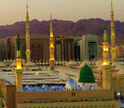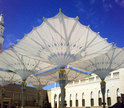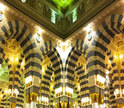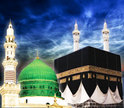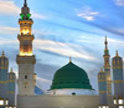Construction of Ka’bah
Blessed by the Lord of the universe with honesty, truthfulness, trustworthiness, incomparably great intellect and wisdom, he صَلَّی اللّٰہُ تَعَالٰی عَلَیْہِ وَاٰلِہٖ وَسَلَّم was extremely famous and was able enough to resolve very serious disputes among the prominent chiefs of the Arabs in his young age. Great thinkers and leaders of the Arabs bowed to his decisions, unanimously acknowledging him to be their greatest chief with authority to decide their matters. There was an incident that occurred on the occasion of the reconstruction of the Holy Ka’bah. Its details are as under:
When he صَلَّی اللّٰہُ تَعَالٰی عَلَیْہِ وَاٰلِہٖ وَسَلَّم was 35 years of age, it rained so heavily that a great flood came in the Haram of the Ka’bah, causing the building of the Ka’bah to collapse completely. The Ka’bah built by Sayyiduna Ibraheem and Sayyiduna Isma’eel عَـلَيْـهِ الـصَّلٰوةُ وَالـسَّلَام had been very old. The tribes of ‘Amaliqah, Jurhum and Qusay, etc. had got the Ka’bah reconstructed and repaired in their times. However, the Ka’bah had been situated in a low-lying area, so the rain water would flow rapidly from mountains to the valley of Makkah, often causing flood in the Haram of the Ka’bah. The Quraysh had also got many dams built on the high-lying area for the protection of the Ka’bah, but the dams would often break. Hence the Quraysh decided to demolish the building and to reconstruct a very strong building of the Ka’bah with a high door and a roof1.
Therefore, the Quraysh started the construction work together. The Holy Nabi صَلَّی اللّٰہُ تَعَالٰی عَلَیْہِ وَاٰلِہٖ وَسَلَّم also participated in the construction, fetching stones shoulder to shoulder with the chiefs of the Quraysh. Different tribes were made responsible for the construction of different parts of the Ka’bah. When it was the time to fix the Hajar-e-Aswad, a serious dispute arose among the tribes. Every tribe wanted to pick up the Hajar-e-Aswad and to fix it into the wall of the Ka’bah so that it would be a great honour for them. Four days passed in the same state with the dispute unresolved. Even swords were unsheathed2.
Banu ‘Abd-ud-Dar and Banu ‘Adee showed open aggression. They took blood oaths by filling a bowl with blood, dipping their fingers into it and licking them; as was the custom in the pre-Islamic era of ignorance. The fifth day, all the tribes of the Arabs gathered in the Haram of the Ka’bah where an old man suggested that the authority to resolve the dispute be given to the person who would be the first to enter the Haram of the Ka’bah the next morning. All agreed. Glory be to Allah عَزَّوَجَلَّ in the highest! The person who was the first to enter the Haram of the Ka’bah was none other than the Holy Nabi صَلَّی اللّٰہُ تَعَالٰی عَلَیْہِ وَاٰلِہٖ وَسَلَّم . Seeing him, all of them said: ‘By Allah عَزَّوَجَلَّ! He is ‘Ameen’ [i.e. trustworthy and truthful]. All of us will accept what he decides.'
He صَلَّی اللّٰہُ تَعَالٰی عَلَیْہِ وَاٰلِہٖ وَسَلَّم found an excellent way to resolve the issue. At first, he صَلَّی اللّٰہُ تَعَالٰی عَلَیْہِ وَاٰلِہٖ وَسَلَّم ordered that one chief from all those tribes who were willing to fix the Hajar-e-Aswad be chosen. Therefore, the chiefs were singled out [i.e. chosen]. Then, spreading his blessed shawl and placing the Hajar-e-Aswad on it, he صَلَّی اللّٰہُ تَعَالٰی عَلَیْہِ وَاٰلِہٖ وَسَلَّم ordered all the chiefs to hold the blessed shawl and carry the Hajar-e-Aswad in it. When the Hajar-e-Aswad was carried to its place, he صَلَّی اللّٰہُ تَعَالٰی عَلَیْہِ وَاٰلِہٖ وَسَلَّم picked it up himself and put it on its place with his own blessed hands. In this way, a fierce war was prevented.3
The building of the Ka’bah was largely constructed but the construction material collected was insufficient. Hence, on a new foundation, a relatively small Ka’bah was built in which some part of the old building of the Ka’bah was not included. The same part of the old building of the Ka’bah which could not be constructed by the Quraysh was called ‘Hateem’ where rain water fell from the blessed drainpipe fixed on the roof of the Ka’bah.
1As-Seerat-ul-Halbiyyah, vol. 1, pp. 204
2i.e. to take a sword out of its cover
3As-Seerat-un-Nabawiyyah li Ibn Hishaam, pp. 79



